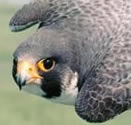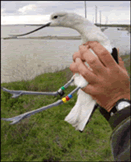|
Contaminants and Birds
Many bird species numbers have declined to dangerously low levels.
Currently, 89 North American bird species are federally-listed as
threatened or endangered species. Pesticides and other environmental
contaminants are considered to be contributing factors to these
declines.
In addition to being responsible for protecting threatened and
endangered species (Endangered
Species Act), the Service also is responsible for enforcing
the Migratory
Bird Treaty Act. These two laws combined offer protection to
virtually all bird species. The Service's Division of Environmental
Contaminants plays an important role in protecting and recovering
bird species. Here are some examples of the types of roles we play:
 Photo by Mike Lockart/USFWS Photo by Mike Lockart/USFWSBald Eagle
The bald eagle once ranged throughout every state in the Union except
Hawaii. When America adopted the bird as its national symbol in 1782,
as many as 100,000 nesting bald eagles lived in the continental United
States, excluding Alaska. By 1963, only 417 nesting pairs were found
in the lower 48 states. Today, as a result the banning of the pesticide
DDT and Service recovery efforts in
partnership with other Federal agencies, tribes, State and local governments,
conservation organizations, universities, corporations, and many individuals,
this number has risen to an estimate 5,748 nesting pairs
Contaminants biologists are involved in monitoring bald eagle populations
and assisting in recovery activities. Some examples include in evaluating
contaminant affects on eagle reproduction in Maine (pdf) , evaluating the potential
impacts of a landfill expansion on eagles in New
York, and determining why eagle breeding success continues to
be low along the Columbia River
in Oregon and Washington and the Hood Canal in Washington.
 Photo by Craig Koppie/USFWS Photo by Craig Koppie/USFWS
Peregrine Falcon
The peregrine falcon is one of nature's swiftest and most beautiful
birds of prey. Its name comes from the Latin word peregrinus, meaning "foreigner" or "traveler." This
impressive bird has long been noted for its speed, grace, and aerial
skills. As with the bald eagle, DDT
was a major factor in the decline of the peregrine falcon which was
listed as an endangered species in 1970. Now, the peregrine is a
symbol
of America's recovering threatened and endangered species. Monitoring
contaminant threats to peregrines in Alaska
 Photo by Glen Smith/USFWS Photo by Glen Smith/USFWSIn 1993, the spectacled eider, an arctic sea duck that sports a distinctive
white eye patch, was listed as a threatened species under the Endangered
Species Act due to its rapid decline on its primary breeding grounds
on Alaska's west coast. After brief summers on Alaska and Russia tundra
breeding grounds, the birds migrate to isolated wintering areas in
the Beaufort, Chukchi, and Bering seas. When listed, the causes for
the dramatic decline in Alaska birds had not been identified. The
main threats to this sea duck on its breeding grounds are now thought
to include: lead poisoning from eating spent lead shot; predation
by foxes, gulls, and jaegers; and hunting and other human disturbances.
Biologists are not certain what threats the eider faces at sea, but
believe threats could possibly be linked to factors that are causing
the decline of other Bering Sea species such as the Steller sea lion.
Lead and the Spectacled
Eider (pdf).
Ravens
In early June 1999, the U.S. Fish and Wildlife Service received
reports of a large number (>20) of dead and dying ravens in
the Sitka, Alaska area. Several carcasses were sent to the
Service's National Fish and Wildlife Forensics
Lab in Ashland, Oregon, where results confirmed that the ravens
died from poisoning by the insecticide Diazinon. Full
Story.
Black-Capped Chickadees
Since January 1998, approximately 300 black-capped chickadees (Poecile
atricapillus) with grossly deformed bills have been reported in
Alaska. Sightings have been clustered in Anchorage but distributed
throughout south-central Alaska. The Service, along with the US
Geological Survey Biological Resource Division, is conducting a
study to determine the cause of the deformed bills. Full
Story.
 A radio-marked avocet is readied for release. Photo by Scott Demers, USGS.
A radio-marked avocet is readied for release. Photo by Scott Demers, USGS.San Francisco Bay has a legacy of mercury contamination from historical mercury mining
in the Coast Range and gold extraction in the Sierra Nevadas.
In a large collaborative project funded by the CalFed Ecosystem Restoration Program, biologists of the U.S. Geological Survey, U.S. Fish and Wildlife Service, San Francisco Bay Bird Observatory, and PRBO Conservation Science are investigating the risks of mercury to waterbirds breeding within the estuary.
Mercury Contamination in Waterbirds Breeding in San Francisco Bay (pdf). From the Don Edwards San Francisco Bay National Wildlife Refuge quarterly newsletter - Tideline
 Oil Field Waste Pits
Oil Field Waste Pits
Two million migratory birds are estimated to die each year in oil
and mining wastewater pits in the western United States. Pits and
open tanks are commonly used to separate any water that is extracted
from an oil-bearing formation along with the oil. Ineffective separation
of oil and water results in wastewater covered by a layer of oil,
creating a death trap for migratory birds and other wildlife. Service
Environmental Contaminants and Law Enforcement staff have played a
crucial role in reducing the number of problem oil pits. Full
Story (pdf).
Links
US Fish and Wildlife Service, Division of Endangered Species Home
Page- http://endangered.fws.gov
US Fish and Wildlife Service, Region 3 - Bald
Eagle: An American Success Story for the New Millennium
US Fish and Wildlife Service, Division of Endangered Species -
Recovery of Peregrine
Falcon
US Fish and Wildlife Service, Region 7 - Threatened
and Endangered Species: Spectacled Eider (pdf)
US Fish and Wildlife Service, Office of Migratory Bird Management
USGS
Alaska Landbird Resource Information System - Boreal Partners in
Flight (See "chickadee alert")
U.S. Fish and Wildlife
Service, Mountain-Prairie Region - Oil
Field Waste Pits: Death Traps for Wildlife. |
